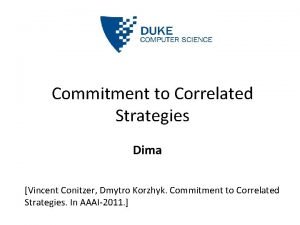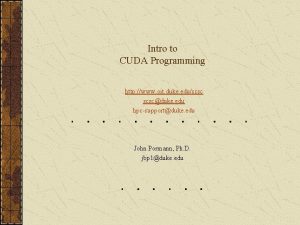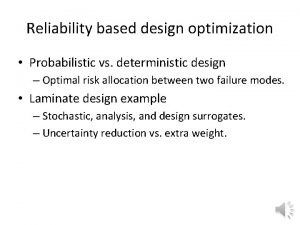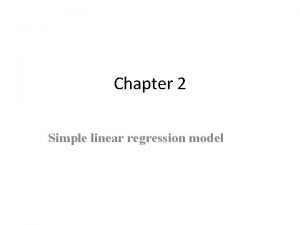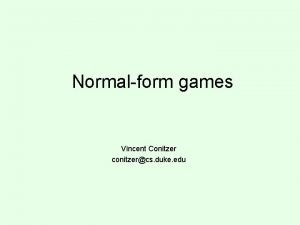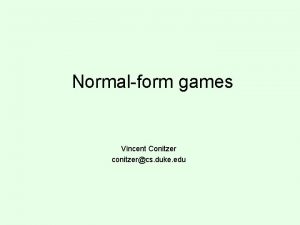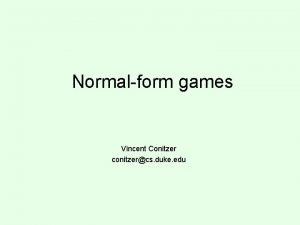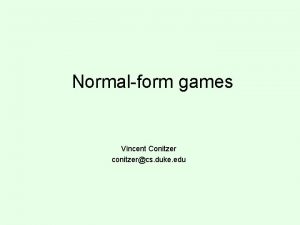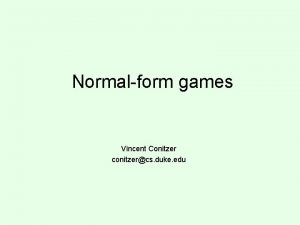Repeated stochastic games Vincent Conitzer conitzercs duke edu













![Shapley’s [1953] algorithm for 2 -player zero-sum stochastic games (~value iteration) • Each state Shapley’s [1953] algorithm for 2 -player zero-sum stochastic games (~value iteration) • Each state](https://slidetodoc.com/presentation_image_h/c7cbd497ad34b7179d0c1742605e1092/image-14.jpg)
- Slides: 14

Repeated & stochastic games Vincent Conitzer conitzer@cs. duke. edu

Repeated games • In a (typical) repeated game, – – players play a normal-form game (aka. the stage game), then they see what happened (and get the utilities), then they play again, etc. • Can be repeated finitely or infinitely many times • Really, an extensive form game – Would like to find subgame-perfect equilibria • One subgame-perfect equilibrium: keep repeating some Nash equilibrium of the stage game • But are there other equilibria?

Finitely repeated Prisoner’s Dilemma • Two players play the Prisoner’s Dilemma k times cooperate defect cooperate 2, 2 0, 3 defect 3, 0 1, 1 • In the last round, it is dominant to defect • Hence, in the second-to-last round, there is no way to influence what will happen • So, it is optimal to defect in this round as well • Etc. • So the only equilibrium is to always defect

Modified Prisoner’s Dilemma • Suppose the following game is played twice cooperate defect 1 defect 2 cooperate 5, 5 0, 6 defect 1 6, 0 4, 4 1, 1 defect 2 6, 0 1, 1 2, 2 • Consider the following strategy: – In the first round, cooperate; – In the second round, if someone defected in the first round, play defect 2; otherwise, play defect 1 • If both players play this, is that a subgame perfect equilibrium?

Another modified Prisoner’s Dilemma • Suppose the following game is played twice cooperate defect crazy 5, 5 0, 6 1, 0 defect 6, 0 4, 4 1, 0 crazy 0, 1 0, 0 cooperate • What are the subgame perfect equilibria? • Consider the following strategy: – In the first round, cooperate; – In the second round, if someone played defect or crazy in the first round, play crazy; otherwise, play defect • Is this a Nash equilibrium (not subgame perfect)?

Infinitely repeated games • First problem: are we just going to add up the utilities over infinitely many rounds? – Everyone gets infinity! • (Limit of) average payoff: limn→∞Σ 1≤t≤nu(t)/n – Limit may not exist… • Discounted payoff: Σtδtu(t) for some δ < 1

Infinitely repeated Prisoner’s Dilemma cooperate defect cooperate 2, 2 0, 3 defect 3, 0 1, 1 • Tit-for-tat strategy: – Cooperate the first round, – In every later round, do the same thing as the other player did in the previous round • Is both players playing this a Nash/subgame-perfect equilibrium? Does it depend on δ? • Trigger strategy: – Cooperate as long as everyone cooperates – Once a player defects, defect forever • Is both players playing this a subgame-perfect equilibrium? • What about one player playing tit-for-tat and the other playing trigger?

Folk theorem(s) • Can we somehow characterize the equilibria of infinitely repeated games? – Subgame perfect or not? – Averaged utilities or discounted? • Easiest case: averaged utilities, no subgame perfection • We will characterize what (averaged) utilities (u 1, u 2, …, un) the agents can get in equilibrium • The utilities must be feasible: there must be outcomes of the game such that the agents, on average, get these utilities • They must also be enforceable: deviation should lead to punishment that outweighs the benefits of deviation • Folk theorem: a utility vector can be realized by some Nash equilibrium if and only if it is both feasible and enforceable

Feasibility 2, 2 3, 0 0, 3 1, 1 • The utility vector (2, 2) is feasible because it is one of the outcomes of the game • The utility vector (1, 2. 5) is also feasible, because the agents could alternate between (2, 2) and (0, 3) • What about (. 5, 2. 75)? • What about (3, 0. 1)? • In general, convex combinations of the outcomes of the game are feasible

Enforceability 2, 2 0, 3 3, 0 1, 1 • A utility for an agent is not enforceable if the agent can guarantee herself a higher utility • E. g. a utility of. 5 for player 1 is not enforceable, because she can guarantee herself a utility of 1 by defecting • A utility of 1. 2 for player 1 is enforceable, because player 2 can guarantee player 1 a utility of at most 1 by defecting • What is the relationship to minimax strategies & values?

Computing a Nash equilibrium in a 2 player repeated game using folk theorem • Average payoff, no subgame perfection • Can be done in polynomial time: – Compute minimum enforceable utility for each agent • I. e. compute maxmin values & strategies – Find a feasible point where both players receive at least this utility • E. g. both players playing their maxmin strategies – Players play feasible point (by rotating through the outcomes), unless the other deviates, in which case they punish the other player by playing minmax strategy forever • Minmax strategy easy to compute • A more complicated (and earlier) algorithm by Littman & Stone [04] computes a “nicer” and subgame-perfect equilibrium

Stochastic games • • • A stochastic game has multiple states that it can be in Each state corresponds to a normal-form game After a round, the game randomly transitions to another state Transition probabilities depend on state and actions taken Typically utilities are discounted over time 1, 1 1, 0 0, 1 0, 0 . 2. 5 2, 2 0, 3 3, 0 1, 1 . 4. 3. 6 1, 0 0, 1 1, 0 • 1 -state stochastic game = (infinitely) repeated game • 1 -agent stochastic game = Markov Decision Process (MDP)

Stationary strategies • A stationary strategy specifies a mixed strategy for each state – Strategy does not depend on history – E. g. in a repeated game, stationary strategy = always playing the same mixed strategy • An equilibrium in stationary strategies always exists [Fink 64] • Each player will have a value for being in each state
![Shapleys 1953 algorithm for 2 player zerosum stochastic games value iteration Each state Shapley’s [1953] algorithm for 2 -player zero-sum stochastic games (~value iteration) • Each state](https://slidetodoc.com/presentation_image_h/c7cbd497ad34b7179d0c1742605e1092/image-14.jpg)
Shapley’s [1953] algorithm for 2 -player zero-sum stochastic games (~value iteration) • Each state s is arbitrarily given a value V(s) – Player 1’s utility for being in state s • Now, for each state, compute a normal-form game that takes these (discounted) values into account. 7 * * -3, 3 * * * V(s 2) = 2 * -3 + 2. 9δ, 3 - 2. 9δ * * V(s 3) = 5 * * s 1’s modified game Solve for the value of the modified game (using LP) Make this the new value of s 1 Do this for all states, repeat until convergence Similarly, analogs of policy iteration [Pollatschek & Avi-Itzhak] and Q-Learning [Littman 94, Hu & Wellman 98] exist V(s 1) = -4 • • * * -3 + δ(. 7*2 +. 3*5) = -3 + 2. 9δ . 3
 Cps 173
Cps 173 Correlated equilibrium
Correlated equilibrium Conitzer
Conitzer Conitzer
Conitzer Cps590
Cps590 Infinitely repeated games
Infinitely repeated games Oit.duke.edu
Oit.duke.edu Outdoor games and indoor games
Outdoor games and indoor games Hunger games chapter 1 questions
Hunger games chapter 1 questions Edu.sharif.edu
Edu.sharif.edu Non stochastic theory of aging
Non stochastic theory of aging Stochastic vs probabilistic
Stochastic vs probabilistic Stochastic programming
Stochastic programming Population regression function definition
Population regression function definition Agent a chapter 2
Agent a chapter 2

